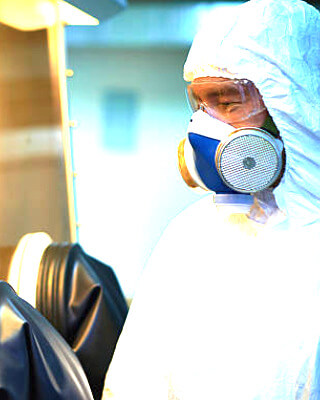All campus labs are needed to complete the Research laboratory Hazard Analysis (formerly LHAT) and also upgrade it at the very least yearly. LHAT helps with the identification of hazards and determines the Individual Protective Tools (PPE) to be used during the defined job activities. All personnel handling chemicals are required to wear. At a minimum, this consists of pants and also closed-toe shoes, chemically resistant gloves, a research coat, and also eye protection.
Use Common PPEs while working with Chemicals:
From extreme chemical burns to deterioration of the skin and skin cancer, protecting the skin is essential to workers’ safety. Coveralls with hoods or other full-body protective fits are usually utilised for body security, and chemical-resistant gloves will protect the arms, hands, and fingers from dangerous materials and skin absorption.
A worker's eyes are also at risk of chemical hazards, and direct exposure or contact can cause irreversible eye damages and even loss of vision. Safety goggles will certainly protect a worker from acids, chemical gases, vapours, and it is especially vital to maintain liquid chemicals for spraying right into the eye. Face shields are an excellent alternative for particularly dangerous chemicals that are at risk for misting or sprinkling onto the face.

Appropriate gloves choice:
When dealing with hazardous chemicals, pick gloves that provide ample defence to the chemical hazards. Nonreusable nitrile gloves supply short-term security against a wide series of chemicals yet do not protect against all chemicals. Glove producers’ websites can be used to establish the best glove for protecting against a chemical.
.
Special PPE for Handling pyrophoric which produces due to chemical process:
When working with pyrophoric the following PPE must be worn from arrangement to quenching of the reaction.
Chemical Splash safety glasses or safety glasses that meet the ANSI Z. 87.1 1989 criterion.
- A faceguard worn over the shatterproof glass is required any time there is a risk of the surge, huge sprinkle hazard, or an extremely exothermic reaction.
- Reusable base gloves must be worn and covered with a non-reusable neoprene glove (equivalent or higher size to protect dexterity). Neoprene/Nitrile gloves must be examined before each use and altered at any type of call and disposed of after each use. Note: The tags on the Kevlar glove must be removed before use, given that the tags themselves are not fire-resistant.
- A Nomex ® laboratory layer with cotton-type garments beneath. Laboratory layers need to be buttoned and in shape properly to cover as much skin as possible.
- Appropriate footwear that covers the whole foot (shut toe, closed heel, no holes in the top) and lengthy pants must be worn.
- Avoid apparel fabrics that are made from polyester or acrylic products.

Respiratory Protection:
Administrative and Engineering Controls ought to constantly be utilised initially to aid make certain direct exposures to dust and fumes from chemicals. If this is not viable, a respirator is needed. The use of a respirator has a number of demands which might consist of the following:
- Annual clinical analyses and health screening.
- Education and training on the appropriate use, storage space, and cleaning procedures for respirators.
- Training on how to readjust tools and guarantee an appropriate fit to take full advantage of protection from dust and fumes.
- If you believe your laboratory/workplace procedures need using a respirator, contact your Department Safety Advisor for assistance.